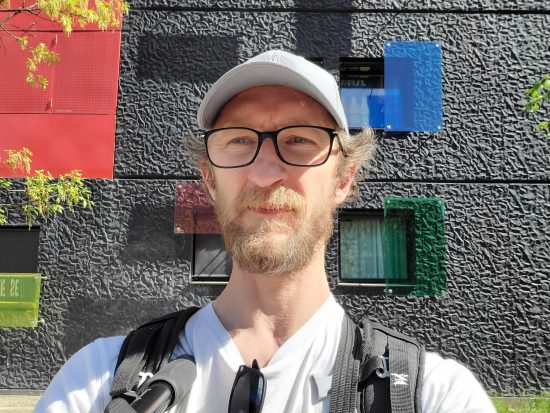The Samsung Galaxy Z Flip’s clamshell design with folding 6.7-inch AMOLED screen makes it an unusual smartphone in the current market. Boasting some impressive specs, including the high-end Qualcomm 855+ chipset with 8GB RAM and 256GB storage, it’s an interesting alternative for those after a smaller and more pocket-friendly flagship with a large screen.
The Z Flip’s front camera utilizes a single standard-array 10MP sensor linked to a wide-angle (26mm-equivalent), f/2.4-aperture fixed-focus lens. While that’s a fairly standard selfie setup, it is a step down from flagships featuring a Quad-Bayer primary sensor, a dedicated depth sensor, and autofocus. For front camera video, though, the Z Flip is a little more up to date, packing in 4K shooting at 30fps.
It’s not all about the spec sheet, though. With the Z Flip putting in a solid performance in our rear camera review, we were eager to see how its selfie shooter shapes up. Read on to discover the scores, ranking, and analysis for the Samsung Galaxy Z Flip in our DXOMARK Selfie front camera review.
Key front camera specifications:
- 10MP sensor with 1.2µm pixels
- 26mm-equivalent, f/2.4-aperture fixed-focus lens
- 2160p/30fps video
About DXOMARK Selfie tests: For scoring and analysis in our smartphone front camera reviews, DXOMARK engineers capture and evaluate over 1500 test images and more than 2 hours of video both in controlled lab environments and in natural indoor and outdoor scenes, using the camera’s default settings. This article is designed to highlight the most important results of our testing. For more information about the DXOMARK Selfie test protocol, click here.
Test summary


With an overall DXOMARK Camera selfie score of 83, the Samsung Galaxy Z Flip ranks in the bottom half of our database for front camera image quality. That’s the same overall score as Samsung’s recent budget-friendly A71, and only a single point improvement on older flagships like Apple’s iPhone XS Max and Samsung’s Galaxy S9+, both at 82.
The Z Flip’s Photo score of 82 is some ways behind top performers such as Samsung’s own S20 Ultra, with lower scores for exposure, focus, texture, and bokeh affecting the score. Results in bright light are usually the most successful, thanks to generally accurate face exposure with reasonably wide dynamic range, as well as pleasant and well-saturated color. That said, our testers found contrast to be a little flat, an occasional warm or yellowish color cast evident in sunny conditions, and detail is low compared to our top performers.
The device’s wide dynamic range ensures bright skies and shadow areas are mainly well exposed, but a slight halo effect around subjects as well as a cyan shift in skies are occasionally visible. Faces can be underexposed in strongly backlit shots, too, and minor exposure instabilities means you often get a slightly different exposure from consecutive shots on the Z Flip.
Good color rendering generally ensures high saturation and pleasant skin tones. Occasional skin tone rendering instabilities can be noticeable across consecutive shots and in shots with a single color prominent in the background, though.
The Z Flip’s fixed-focus lens captures the best detail with subjects around medium range (55cm). It’s not bad at close range, but get a little too close and the focus is just a little bit off. Depth of field is quite narrow, too, so expect a further loss of detail both in backgrounds and on faces towards the back of group selfies.
When you hit the focus sweet spot, detail in faces is pretty good in outdoor shots, but good texture rendering drops off quickly indoors and especially in low light, where the device’s long exposure time doesn’t really help. Noise is generally well controlled, and although it becomes slightly visible in faces in indoor shots, outdoors it’s very good. The same can’t be said in low light, however, where a very obvious buildup of coarse noise starts to become distracting.
Bokeh is another area for improvement on the Z Flip, with the effect occasionally failing to activate when requested. Even when it is applied, depth estimation artifacts are often visible around the edges of the subject and there’s no realistic blur gradient rendering, so the background is always blurred the same regardless of the distance. Flash pictures are a strength, however, thanks to good exposure with and without additional lighting, as well as good color rendering and accurate white balance ensuring nice skin tones. Detail is again quite low, though, and heavy corning shading is evident in all flash shots.
The camera performs comparatively better in video mode than for stills. Shooting 4K video, the Z Flip delivers high levels of detail, particularly in outdoor or bright-light environments. It’s not bad indoors, either, but try to avoid low light, as texture is a little poor and both chromatic and luminance noise are very visible. Fixed-focus is an issue for video, too, with the lens’s limited range of focus resulting in lower detail in faces too close or too far from the camera, but you won’t have too many complaints at medium range.
Faces are generally well exposed in both outdoor and indoor videos, and although the dynamic range isn’t the best we’ve seen, it does a pretty good job of handling the highlights and shadows in most videos. Color remains well saturated in videos, too, and skin tones are generally pleasant. The Z Flip’s stabilization is pretty effective in correcting any serious motion problems in handheld static and walking videos, but some moving texture and color quantization artifacts are occasionally visible.
Conclusion
Overall image quality from the Z Flip’s front camera is quite a ways off the performance of other recent flagships we’ve tested. Although indoor and outdoor exposure, dynamic range, and color are more than reasonable, they’re not excellent. Add to that limited range of focus and low texture, mediocre bokeh shots, as well as generally poor low-light results, and selfies from the Z Flip won’t blow your socks off. With its folding screen the main selling point, you may be prepared to sacrifice a bit of camera quality for its convenience and portability, but there are better performers for serious selfie shooters in this price range.
Photo
Pros
- Vivid and pleasant color
- Generally accurate exposure
- Well-controlled noise outdoors
- Accurate exposure using flash
Video
Pros
- Accurate exposure with wide dynamic range
- Effective stabilization
- Good detail in outdoor videos
- Pleasant skin tones
Cons
- Strong noise in low light
- Poor detail in low light
- White balance errors indoors
- Out-of-focus faces at close range
- Texture and color quantization artifacts










DXOMARK encourages its readers to share comments on the articles. To read or post comments, Disqus cookies are required. Change your Cookies Preferences and read more about our Comment Policy.